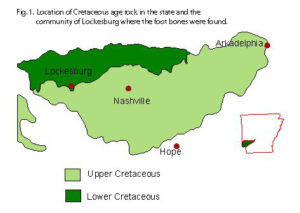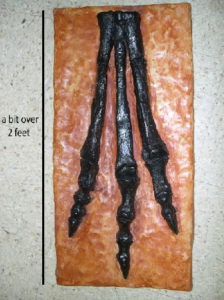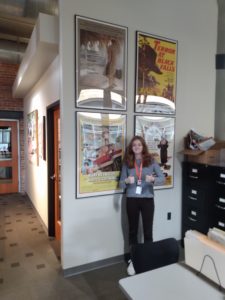calsfoundation@cals.org
Arkansaurus Fridayi: The Buried History of Arkansas’s State Dinosaur
When I was little, my brother and I were fascinated by dinosaurs. To us, the Museum of Discovery was the pinnacle of the display of innovative research and finding rocks with imprints of fossils in a dry creek bed was an extreme excavation.
Flash forward to the evolution unit of my high school biology class. I was intrigued by phylogenetic trees and homologous structures; my childhood love of science clearly had not disappeared. When I went to Washington DC with my youth group this spring, I practically begged to go to the Smithsonian National Museum of Natural History. (It was just as epic as I had imagined it.) So naturally, I was shocked and delighted when I discovered there was a folder about Arkansas dinosaurs in the vertical files in the CALS Roberts Library Research Room. It was very thin, only one item: an Arkansas Life magazine entry from 2014. Unbeknownst to me and I am sure a sizable percentage of Arkansans, we have an official state dinosaur!
 Bones of the ornithomimid dinosaur were discovered by Joe B. Friday in 1972 in a shallow pit on his land in Lockesburg (Sevier County). Between Friday, who found a few bones initially, and later James Quinn, a geology professor at the University of Arkansas, three metatarsals (long bones in feet), four phalanxes or phalanges (toe bones), and three unguals (claws) were discovered to make an almost complete right foot.
Bones of the ornithomimid dinosaur were discovered by Joe B. Friday in 1972 in a shallow pit on his land in Lockesburg (Sevier County). Between Friday, who found a few bones initially, and later James Quinn, a geology professor at the University of Arkansas, three metatarsals (long bones in feet), four phalanxes or phalanges (toe bones), and three unguals (claws) were discovered to make an almost complete right foot.
This particular dinosaur, named the Arkansaurus fridayi, has not been researched by many scientists, so what we know about it is largely thanks to Rebecca K. Hunt’s continued research into the fossils. Ornithomimid dinosaurs were fast, emu-like, and slightly larger than a human. For reference, you might know the Galimimus, the fast, large, ostrich-looking thing from the movie Jurassic Park; it was another ornithomimid similar in size and shape to the Arkansaurus fridayi. Although the diet of the ornithomimid is unclear, it was most likely small animals, eggs, and lots of plants.
This dinosaur hails from the early Cretaceous period in the trinity group, a lithostratigraphy (a portion of the rock structure categorized by rock type) of Texas, Arkansas, Mississippi, Louisiana, and Oklahoma. Arkansas at the time Arkansaurus lived was only partially submerged, which means that the rock in most of the state contained sand, gravel, clay, limestone, and evaporite (such as gypsum) deposits.
My hunt for more information on the Arkansaurus fridayi also led me to the entry on it in the CALS Encyclopedia of Arkansas, but if it were not for the vertical files, with their folders full of unique newspaper clippings, magazines, and other papers stored in an alcove of the Roberts Library, I would have had no idea that this humble state harbors so much rich history.

By Zoë Simmons, CALS Roberts Library summer intern, 2022
***
A note about the Roberts Library vertical files from Rhonda Stewart, CALS local history and genealogy specialist:
This summer, our intern Zoë Simmons worked on “managing” vertical file materials to make them more effective for staff to use and re-shelve. The African American section has been labeled with a black sticker on all files and drawers. This section was developed before my time with the library, and it has been useful to patrons over the years. The reason for the putting it in a unique section is “the big fish, little pond theory.” There are biographies and topics in those files that may not have significance (in larger historical commentary) until someone decides it is a worthy topic of historical research. My familiarity with this community has guided many of the additions during my tenure. Several researchers have found useful clues throughout the entire vertical file holdings. We will also be designating other sections with color coding (artists, authors, etc.) in the near future.




